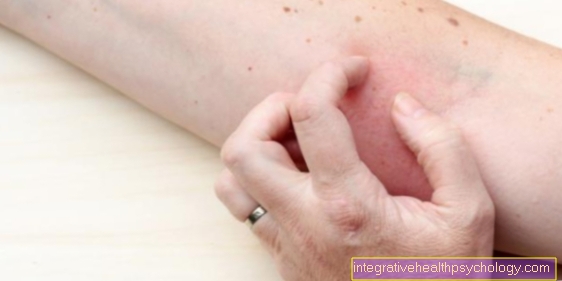Black birthmark - how dangerous is it?
introduction
Everyone has birthmarks and moles. A birthmark is made up of a collection of cells that make pigment, called melanocytes or similar nevus cells. Birthmarks have an even tan, while nevus cells form a point-like tan. Colloquially, both forms are called birthmarks. A birthmark can be flat or raised and colored differently in brown. A birthmark can be so dark that it appears almost black. A malignant skin tumor, the melanoma, can develop from a birthmark. Irregular blackening can indicate skin cancer. If you suspect malignancy of a mole you should always consult a dermatologist.

These symptoms can indicate malignancy!
A harmless birthmark does not usually cause any symptoms. Symptoms such as itching, oozing, or bleeding from the mole can indicate malignancy of the mole and require a dermatological examination. If black skin cancer is actually present, accompanying symptoms can occur. Outwardly, the birthmark looks darker than other birthmarks and is primarily colored (pigmented) differently. This means that there are different colors within the mole. A birthmark becomes noticeable when it grows faster and looks different than the other birthmarks on the body. As long as a melanoma is still thin and superficial, the prognosis is very good and the chances of recovery are 100%. However, if left untreated, melanoma will continue to grow. Untreated melanoma can penetrate deeper into the skin over time and spread through the body via lymph and blood vessels. The cancer cells of skin cancer can be deposited in organs such as the lungs, bones, liver or brain and reach lymph nodes via the lymph where metastases (settlements of tumor cells) can grow. If a metastatic malignant melanoma is actually present, the symptoms can vary depending on the organ involvement. Therefore, as soon as symptoms such as itching, bleeding or oozing occur in the area of moles that are not known from other moles, always consult a dermatologist and have a screening done.
For more information on this topic, we recommend our page on: These are symptoms of skin cancer
Black birthmark is bleeding
Sudden bleeding from a black mole should definitely be viewed as a warning sign. A birthmark can bleed if it is injured, for example when shaving. If the birthmark bleeds for no apparent reason, the bleeding can repeat itself and be accompanied by crust formation and pain. If a black birthmark bleeds without a previous injury, you should call the dermatologist immediately and make an appointment for a screening to rule out malignant skin cancer. The same applies to bleeding from scratching due to itching in the area of the mole.
Black birthmark itches
Normally, a birthmark doesn't itch. An itchy birthmark can indicate that it is black skin cancer (malignant melanoma). It is not uncommon for the itching of malignant skin cancer to unconsciously scratch and the birthmark to bleed. In any case, if itching in the area of the birthmark, you should consult the dermatologist and have the birthmark examined. Itching is a clear alarm signal!
Also read: Birthmark itches - when is it dangerous?
Examination of birthmarks
Most birthmarks are harmless. In order to distinguish dangerous birthmarks from harmless ones, the dermatologist examines the black birthmark with a dermatoscope, a magnifying glass. The dermatologist uses the ABCD rule to examine the spots. A for asymmetry, B for limitation, C for color and D for diameter. Moles that are asymmetrically shaped, have irregular borders and a diameter of more than 6 millimeters are suspect. Different shades of color in a birthmark also make it suspicious. The diagnosis of whether a black birthmark is actually dangerous can only be made by means of a biopsy after the birthmark has been removed.
In order to recognize dangerous birthmarks in good time and, if necessary, to remove them, skin cancer prevention is of great importance. For more information, we recommend our website to: Skin cancer screening
How is malignancy of the birthmark recognized?
The dermatologist's ABCD scheme can help assess the risk of a suspicious mole. However, malignancy can only be proven histologically. This means that a mole needs to be removed and thoroughly examined to prove that it is malignant skin cancer.
Also read: Skin cancer screening
When does a black birthmark need to be removed?
As part of a screening, the dermatologist decides whether a birthmark needs to be removed or not. Based on clear guidelines, the family doctor decides whether a birthmark is at risk of degenerating into skin cancer or not. If a malignant birthmark is suspected, it is removed and a biopsy is performed. Only then can one say with certainty whether the birthmark was actually malignant or not.
Also read: Identify and remove birthmarks
How is a birthmark removed?
If malignancy is suspected, a birthmark is removed under local anesthesia. The size determines the procedure. Very small birthmarks can often be punched out, while larger birthmarks can be cut out with a scalpel. The wound is then sewn with one or more stitches. The fresh wound must not come into contact with water for a certain period of time and sports activities must be avoided for about two weeks.
Further information on this topic can be found at: Remove birthmark
Prognosis of a black birthmark
Most birthmarks are harmless and do not cause discomfort. From a medical point of view, it is often not necessary to remove a birthmark. In fact, some moles even recede on their own. Suspicious birthmarks should be checked regularly and, if necessary, removed and examined. If black skin cancer (malignant melanoma) is detected early, the prognosis is significantly better.
For more information about the prognosis of black skin cancer, see: Melanoma
I have a lot of birthmarks - what's behind them?
There are factors that favor the appearance of birthmarks. On the one hand there are hereditary factors, the skin type and the pigment melanin. Scientists assume that the more frequent birthmarks appear in relatives, the more likely it is to get numerous birthmarks. In addition, there are generally more moles in light skin types than in dark skin types. A fair skin type and many birthmarks in the family favor the occurrence of birthmarks. A clear cause is not known.
Black birthmark after sunburn
The risk that a harmless birthmark will degenerate into a malignant black skin cancer is strongly influenced by exposure to the sun. Severe sunburn, especially before the age of twenties, increases the risk of developing melanoma. If you have often suffered from sunburn in the past and discover a black birthmark, you should have it examined. A black discoloration immediately after sunburn is rather unlikely.
Further informationAlso read:
- These are symptoms of skin cancer
- Birthmark itches - when is it dangerous?
- Melanoma - black skin cancer
- Skin cancer screening
- Identify and remove birthmarks





























